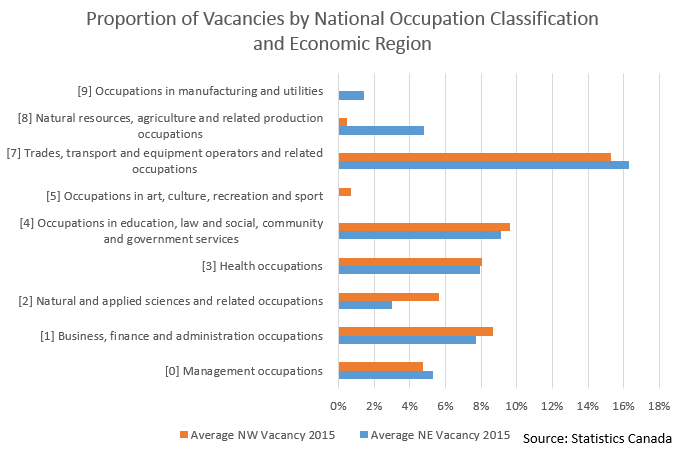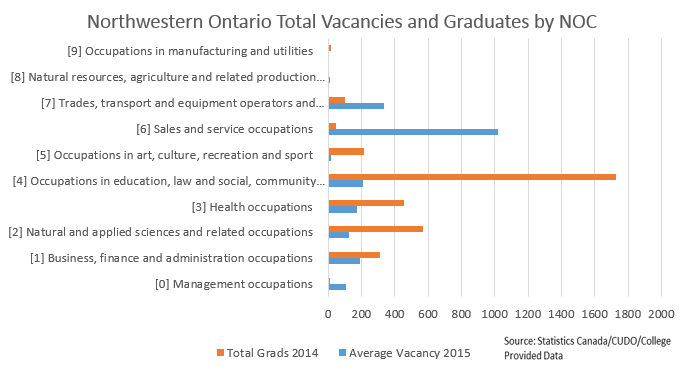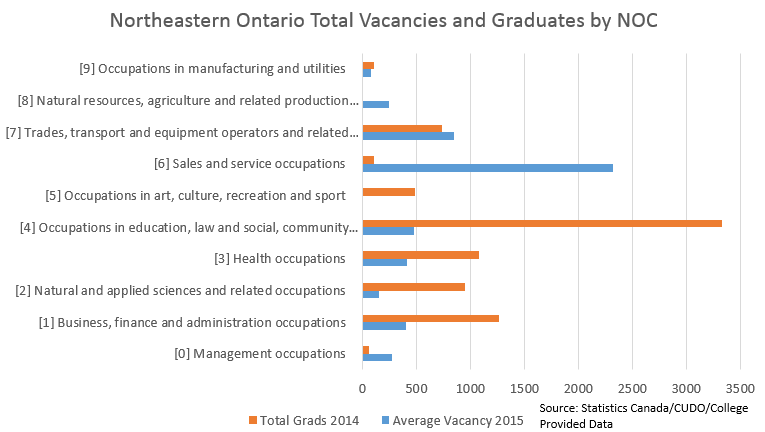Labour Market Alignment: Education in the North
August 15, 2016 - Aligning the supply and the demand of the labour market is indispensable to overall economic efficiency. With trends such as a declining population, youth out-migration and a growing skills gap in Northern Ontario, there is an increased need to ensure that the job supply meets demand and that young adults have the education and skills to fill these vacancies.
One major source of supply for the Northern Ontario labour market is the region’s postsecondary institutions.[1] While these colleges and universities cite the need to be responsive to the current labour demands, it is unclear how or if this is translating into policy.
Using current data from the Job and Wage Vacancy Survey published by Statistics Canada, it is apparent what types of jobs are most in demand. Similarly, using graduation rates from the regions post-secondary institutions taken from Common University Data Ontario (CUDO) and from numbers compiled by the colleges themselves, it is also clear what skillsets are being fed into the supply chain.
Using the Job and Wage Vacancy Survey, as categorised by National Occupational Classification (NOC), the sales and service sector is home to the largest job vacancies across the North. However, these vacant positions generally do not require any professional or other type of certification, and instead many of these vacancies require only a high school diploma or less. Thus comparing vacancies with graduation data will be of little use.[2]

Following sales and service, both regions have the greatest vacancies in trades, transport, equipment operators and related occupations (333 in the Northwest, and 851 in the Northeast).
To determine the supply of graduates in each NOC category, each program graduated from was classified within the NOC in which the program best aligned (i.e. nursing grads went under “Health Occupations”).[3] This method has its limitations but was diligently created to best align programs with occupational classifications.[4]
The discrepancy that poses one of the greatest risks to the Northern Ontario labour market exists in the trades, transport, equipment operators and related occupations. In the Northeast, there were over 100 more vacancies than graduates, and in the Northwest this gap is over 200.


This misalignment has major implications for the economies of the region, as the Conference Board of Canada estimates that the skilled workers gap is estimated to cost the Ontario economy upwards of $24.3 billion a year in foregone GDP.
The need for more skilled trades people has been echoed by many in the North, such as the Thunder Bay Chamber of Commerce who recognizes these jobs are essential for growth and development.
It is not apparent that this shortage is purely due to a lack of students as both regions produced more graduates than there were vacancies in 2015. Instead it may have more to do with a major misconception surrounding skilled trades education in Ontario, namely that these fields are often misguidedly perceived as inferior to university programming.
To increase the supply of graduates into related programs, the perception of the skilled trades will need to be changed. This societal change isn’t one that will occur overnight, but there are a number of things that can be done to ensure it happens over time.
This simplest step is for parents, high school teachers and guidance counsellors alike to stop regarding the skilled trades as a “second-best” option, but rather a viable option for students of all academic abilities.
Fortunately for Northern Ontario, the low social acceptance of the trades is not a worldwide phenomenon, and we can look to an example in the European world for further guidance.
In Germany, which boasts a “dual system” for education (giving students the option to split the upper years of their secondary schooling between the classroom and workplace training) 82% of the public have a positive perception of vocational training. This is no doubt linked to the true value given to every type of career.
Ontario does not need to reinvent the wheel when it comes to education, but there are steps it can take to improve the situation. The Ontario Youth Apprenticeship Program (OYAP), which gives secondary school students hands on experience, and accreditation, in any number of skilled trades, is essentially Ontario’s trade specific equivalent.
Expanding OYAP, and marketing it to students of all academic inclinations would be integral to showcasing the true value of vocational training, decreasing the stigma surrounding it, and would potentially boost future supply to the regions PSE’s.
Undertaking these measures would greatly benefit the economy of Northern Ontario. Closing the skilled trades would boost the region’s GDP, as well as tax revenue.
A more aligned labour market would also lead to lower levels of unemployment, and therefore less unemployment beneficiaries. Aligning the market would also mean less out-migration from the region, especially for the extremely mobile youth.
Northern Ontario has the graduates to fill the various vacancies in the labour market, it is time to make efforts to ensure educational institutions truly remain responsive to needs of the region by removing the stigma surrounding trade related programs.
Jarrod Sundmark is a policy intern at Northern Policy Institute.
The content of Northern Policy Institute’s blog is for general information and use. The views expressed in this blog are those of the author and do not necessarily reflect the opinions of Northern Policy Institute, its Board of Directors or its supporters. The authors take full responsibility for the accuracy and completeness of their respective blog posts. Northern Policy Institute will not be liable for any errors or omissions in this information, nor will Northern Policy Institute be liable for any detriment caused from the display or use of this information. Any links to other websites do not imply endorsement, nor is Northern Policy Institute responsible for the content of the linked websites.
Northern Policy Institute welcomes your feedback and comments. Please keep comments to under 500 words. Any submission that uses profane, derogatory, hateful, or threatening language will not be posted. Please keep your comments on topic and relevant to the subject matter presented in the blog. If you are presenting a rebuttal or counter-argument, please provide your evidence and sources. Northern Policy Institute reserves the right to deny any comments or feedback submitted to www.northernpolicy.ca that do not adhere to these guidelines.
